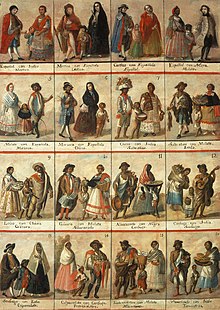Casta (Latin America)
The expression casta ( Spanish / Portuguese " caste "; plural castas ) was a name in Latin American countries for the descendants of associations of different population groups , mainly descendants of black Africans , Europeans and Indians , the natives of the American double continent. The sometimes very complicated distinctions are an expression of an equally fine social gradation, which was usually associated with social and legal discrimination, especially the greater the number of indigenous or black African or African American ancestors in the family tree. Accordingly, the names of the castas usually have a disparaging character. In Mexico, for example, they were legally subordinate to the Indians, whose rights were protected. Today these terms are hardly used anymore. They reflect the social fabric of Latin American societies as it existed well into the 20th century.
The Latin American caste system
In the 18th century, the Age of Enlightenment, the following classification developed in New Spain (Mexico):
- From Spaniards and Indígena - mestizo
- From Indio and Black - zambo / lobo
- Made of black and zamba - zambo prieto
- From white and black - mulato
- From mulatto and white - morisco
- From Spaniards and Morisco - albino
- From albino and white - saltatrás (or saltapatrás)
- From Indio and Mestizo - coyote
- Made of white and coyote - harnizo
- From Coyote and Indio-chamizo
- From Morisco and Spanish - chino
- Made of chinos and Indian women - cambujo
- From Cambujo and Indian woman - tente en el aire
- From tente en el aire and chino - no te entiendo
- From mulatto and tente en el aire - albarazado
A slightly different classification, which also indicates social status (No. 1 relatively high reputation, 16 lowest reputation):
- Mestizo: Spanish father and native American mother
- Castizo: Spanish father and mestizo mother
- Espomolo: Spanish mother and Castizo father
- Mulatto: Spaniard and black African
- Moor: Spanish and Mulatto
- Albino: Spanish father and moor mother
- Throwback: Spanish father and albino mother
- Lobo (Wolf): Throwback father and Native American mother
- Zambiago: Lobo father and Indian mother
- Cambujo: Zambiago father and Indian mother
- Alvarazado: Cambujo father and Mulatto mother
- Borquino: Alvarazado father and Mulatto mother
- Coyote: Borquino father and Mulatto mother
- Chamizo: Coyote father and Mulatto mother
- Coyote-Mestizo: Chamizo father and Mestizo mother
- Ahi Tan Estas: Coyote Mestizo father and Mulatto mother
Membership in one of the higher castas was a prerequisite for admission to a spiritual order or a call to a public office. It had to be proven according to the regulations of the Limpieza de sangre ("blood purity"), a norm that emerged in late medieval Spain, according to which Marranos and Moriscos were excluded from the various elites. Since in the Spanish colonial empire the necessary genealogical evidence could often not be provided, the responsible authorities judged according to the phenotype, which led to an arbitrary classification. There are reports of cases in which the same person was assigned different castas on different occasions . In addition, evidence of Limpieza de sangre could be bought in the colonies, so that the desired preservation of a homogeneous, early Christian-European upper class and its separation from supposedly inferior castas did not succeed.
Castas in 19th century Mexican society
In 1810 only 0.2% of the then population of Mexico (6 million inhabitants) consisted of Spaniards, 16% of Creoles, i.e. descendants of Spaniards, 22% of Castas, 60% of Indians, 0.1% of sub-Saharan Africans . Among the Castas, the mixtures of Europeans and Indians were most numerous.
literature
- David Grewe: Ethnicity, Citizenship and Belonging in the Age of Revolution. Africans and indigenous people in Mexico around 1800. Böhlau, Cologne 2016, ISBN 978-3-412-50575-2 .
- Itzel Rodríguez Mortellaro: Mestizos y castas ( Memento from July 22, 2010 in the Internet Archive )
- Roland Soong: Racial Classifications in Latin America. Zona Latina, 1999
Web links
Individual evidence
- ^ Nikolaus Böttcher: Genealogy in Hispanoamerica. "Blood purity" and the Castas Society in New Spain in: Michael Hecht (Ed.): Selection - Initiation - Representation. The ancestral test in the premodern. Rhema-Verlag Münster 2011, pp. 387-414.
- ↑ Stefan Rinke: Limpieza de sangre [purity of blood]. In: Wolfgang Benz (Hrsg.): Handbuch des Antisemitismus . Volume 3: Concepts, ideologies, theories. De Gruyter Saur, Berlin 2008, ISBN 978-3-598-24074-4 , p. 192 (accessed via De Gruyter Online).



